PART ONE - THE HARDWARE YEARS
NOTE - I no longer own any of these instruments!! Since I've had some inquiries about them, I just wanted to note that they are not in my possession any more!
I suppose it's the vile influence of 'Progressive Rock' bands (Yes, ELP, Genesis, etc) during my youth in the 70s that made me long to play synthesizers. The seminal Minimoog made 'synthesizer' a household word in the 70s, and so I hoped that one day I could afford one of the astronomically priced wonder boxes. Thankfully I was still young in the days when the portable keyboard revolution began, and so you'll see a measured progression from cheap Casios and Yamaha portables up through behemoths like the Kurzweil. So welcome to the torqued tale of the 20-odd keyboards that have spent some time in my clutches...
CASIO VL-1(VL-Tone)

I was presented with my first keyboard on Christmas 1981, the VL-Tone (VL-1) from the gods of Casio. I was 19 years old and had already spent many hours pawing over home keyboards in Deutsche department stores in downtown Berlin, and at last I had one of me own. I'd read a few books on synthesizers, so I was delighted that the VL-1 had an envelope function and could store one (wow!) customized sound. I was actually able to use it on stage that year with a high-school band, performing the synth part in Rush's "Tom Sawyer". Soundwise it's become a cliche (thanks in part to Trio's "Da Da Da"), but had a lot of swell features. I gave it away many years ago.
CASIO MT-40

My first polyphonic keyboard. I think I paid $200 for this thing new in 1981 or 1982. I was just keen on getting something I could play chords on, and this was about the cheapest way at the time I could find. From 1982-1985 it was my main keyboard and composed many a tune on it. I favoured the piano preset, and occassionally the other sounds (eight, I think). It had the usual nonsense that home keyboards did, preset rhythm patterns, but mostly I just used the drum patterns and the piano sound.
PAIA GNOME
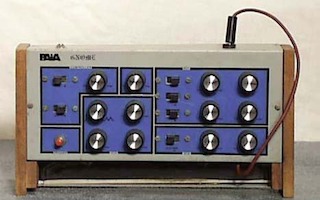
This was from a company called Paia (that's still around) which sold various electronic kits, including this midgit synth called the Gnome. I had been getting Paia's catalog for a while and bought this kit was under $100, I think. I assume I got it in 1982 or so. I had already assembled a Heathkit TM-1626 mixer, so thought I could manage this small synthesizer kit. Sadly all I ever got out of this sound-wise was some occasional blips of white noise. It triggered sounds by wiping a metal stylus along a ribbon, but I must have botched the kit somehow. And that kept me from trying my hand at any other kits from that point on.
YAMAHA CS-01
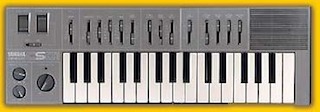
The first proper keyboard synthesizer in my kit, even though it looks like yet another portable 'home' keyboard. I found this as a discount item at a music store that was going out of business in 1982/83. I think I paid $125 for it (half off list). This was the last analogue synthesizer that Yamaha made, and had a rich sound for a li'l mono, perhaps as it was made of the similar stuff as the legendary Yamaha CS-80. It had a breath controller, which would allow you to tweak the sounds as you breathed into it, but I found it damn near painful to use, so I didn't bother. I didn't think it was too great for bass sounds (save phasing drones), but was perfect for wanking lead lines. A great, fat little synth, but I traded it up in the late 80s when I was in the throws of FM mania (what a mistake).
ROLAND SH-101
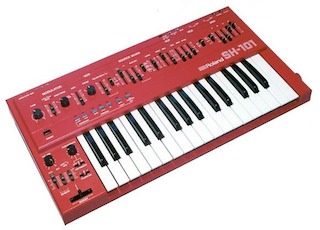
After 4 years of dabbling with mini-keys, I purchased a synth with full-sized keys. I found this used for $250 in a Los Angeles music shop. The model I had was red in colour (it was also available in blue and grey). It certainly outclassed my CS-01 in terms of control, but it didn't quite have the same fat, phasing sound. However, where my CS-01 was lousy for bass, the Roland was idealy suited for it. I think of the this Roland's sound as "rubbery". The thumping bass sound that has become a techno-cliche was what I used it for most. It could do lots of other sounds too, like effects patches and arpreggiated stuff. I sold this to a friend in the late-90s as I just wasn't using it anymore, but I do miss it sometimes.
KORG MONO/POLY
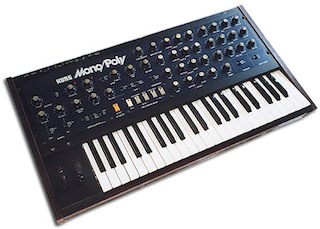
I had been lusting after this synth since 1982, and recall drooling over this advert for th synth. Yet at $1000 list, it was out of my financial reach until about 1985. I paid $500 (on layaway) for a slightly used model. Everyone i knew that was getting into synths got the Korg Polysix, which came out at the same time. I couldn't understand why, even if you had more voices, as the Mono/Poly had a half-acre of knobs and four oscillators! Although it did sound rather weedy when used polyphonically, so i rarely did, but in mono mode it was a screamer. Though it functions well as a bass & lead synth, it has a great ability for modulated effects sounds via the cross-mod section. This was let go as Korg did a very good job of virtualizing this with their Analog collection.
YAMAHA VSS-100
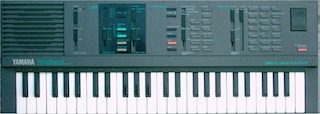
By the mid-eighties digital sampling became an everyday term in pop music, although the machines that did sampling cost as much as an automobile (and in some cases as much as a house). This was the first instrument that was cheap enough for poor musicians like me in the 80s, and sometime around 1986 I got this board. It had FM tones and would sample up to eight seconds of time (or four two-second multi-samples). To be sure, the quality was pretty grainy, but was a lot of fun and made for some groovy compositions (if a tad on the novelty side).
CASIO SK-1

The one down side of my VSS-100 is that it would not play samples polyphonically, and Casio's legendary SK-1 could. My friend Harald showed me this, and I was amazed, and rushed out the buy one right away. My favourite sample was to sing a note right into the built-in mic and create a looping chorus sound. I also did the requisite silly noises and cliche' vocal fragments (ala Art Of Noise). It's worth noting that this amazing li'l bugger had some additive synthesis capabilities and other swell stuff.
YAMAHA DX-100
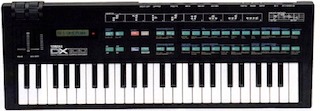
Before sampling took over, the keyboard world was deep in the throws of the Yamaha DX-7, and Yamaha issued a plethora of variations of it's FM (Frequency Modulation) sound method. After a few years of FM big-boys, they issued an FM synthesizer that was cheap enough for my thin wallet, the DX-100, priced at $450/list. I was quite fascinated by the idea of Yamaha's FM synthesis, as it was completely different than the analogue synthesis I'd spent years learning. My first encounter with a DX-7 was in the same LA music store i purchased my SH-101 in, and made me think of a complicated geometry story-problem with a keyboard attached.
So, I soldiered thru and taught myself FM synthesis, spent many an hour on this humble little keyboard. I purchased endless FM books and tutorials and still felt like I was a mere novice in a forest of algorithm frequency ratios and carrier to modulator relationships - phew, FM wuz tuff stuff. But the one thing it offered was a new level of acoustic emulation, so I used it often. But I also did a lot of amusical sounds, which were pretty easy to achieve once you knew some FM basics.
YAMAHA FB-01

This was probably the synth that I owned for the shortest amount of time. I was very keen to tap into the lastest technical thang called MIDI. Yamaha made this cheap li'l half-rack box to give penniless boys like me a way to expand their studio. It was essentially a preset box of 200-odd sounds, which was most useful as a way to thicken up the notoriously thin sound of FM synthesis. It was not that easy to use, and wasn't editable, so it was just MIDI stopgap for me.
YAMAHA TX-81Z
![]()
I was really angry at Yamaha when this came out, as it was everything that the FB-01 wasn't. It was editable, had microtonal tuning capabilities, extra waveforms, etc. I was angry because I'd blown $350 on the FB-01 and the TX-81Z was just a bit more expensive and much more capable. So, having owned the FB-01 for less than a month, I traded it in (taking a significant loss) for the deeper pastures of the TX81Z. I traded this in (along with my DX-100) to get a DX-11.
This instrument made up for a lot of the weaknesses in the low-end FM synths, and though a bitch to program, I was getting pretty good at doing FM sounds by this time, and did a lot of patches for it, which transferred to my DX11 nicely.
OBERHEIM MATRIX-6R

By 1987 or so, I was starting to get sick of FM synth sounds. I had emmersed myself so deeply in FM for a couple of years, that everything started to sound the same, cellos sounded like trumpets, etc. In the mid-80s, Oberheim created the mother of all MIDI modules, the Xpander. But the list price was a paltry $3000/list, and so, like so many synth makers, they cut out features and generous interface of the Xpander, and released the Matrix-6R. I remember opening this thing, triggering the sounds and thinking "Ahhhh, analogue at last!". It was a breath of fresh air after years of FM. Programming this Matrix-6R was a bitch, but the sounds were worth it, and there was enough modulation fun left over from the Xpander architecture, that one could make plenty of unique sounds. After getting some very good analog virtual synths, I finally parted with this, hoping one day someone will create a virtual Matrix-12.
CASIO SA-20

I liked this silly thing so much I got two of 'em back in 1989! Something of a throwback to my Casio days in the early 1980s, I was enchanted by this little keyboard, which had pretty wide range of the good sounds, and for reasons which still elude me, I got two. They could only play 4 notes at a time, and had no performance controls, but hey, after years of FM and Analog, it was just dumb fun.
YAMAHA DX-11
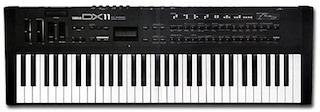
Essentially a TX-81Z with a keyboard and a few extra features. This was the first full-sized keyboard I ever owned, aquired sometime around 1989, by trading in both my DX-100 and TX-81Z and $500. The sounds were nothing new, but this keyboard was my workhorse for most of the 1990s and finally collapsed under the strain. I was breaking keys with monotonous regularity and finally sold this at a fire-sale price to a friend.
ENSONIQ ESQ M
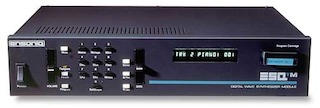
A rack version of the seminal Ensoniq ESQ-1, which was an amazing instrument when it came out, perhaps the first synth 'workstation', combining a sample-playback, basic drums and sequencing. The modular ESQ-M didn't have a sequencer, but had the same sound engine. What made this humble box so good was a combination of excellent samples and a versitile synthesis capabilites. You could layer three samples/waveforms, which pass thru an analog filter, which made it a great hybrid between analog and digital.
Sadly, at the time I had purchased this great synth module, I was in financial straits, and had to sell it. By the time I was solvent again, I didn't like the direction that Ensoniq had taken with the SQ-80 and VFX, and was fixated on vector synthesis, hence the aquisition of the following two synths...
YAMAHA TG-33
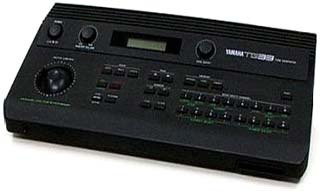
Another 'compromise' synth. When the Korg Wavestation was released, I knew that was my kind of synthesizer. While the synthesizer industry was busy trying to create the 'ultimate workstation', Korg came out with a 'synthesists' synth, not a workstation retread. However, the $2000 ticket to Wavestationland was out of my grasp, and when Yamaha issued the SY-22/TG-33, I knew they had me in mind. I liked the TG-33 because it was a throwback to tabletop synths like the Oberheim Xpander. I think it cost me $600 and was a great little box. It was a combination of FM and wavesamples and had some unusual sounds that were on the industrial side of things. When I got the Wavestation SR (below) this kind of faded into the background and so I finally sold this...but miss it sometimes.
KORG WAVESTATION SR
![]()
All the Wavestation gubbins crammed into a tiny rackspace. I have never had a synth that was harder to program, but I programmed this one with a tenacity that I've never had since. The wonderful sounds were worth the trouble. I probably programmed several hundred sounds, and used this instrument for many projects, some of which paid for this unit. This was the ambient synth deluxe, lots of spacious airy-fairy sounds and whacky rhythmic tones too. I added a couple of expander cards (Ethnic & Synth Design). Since Korg released the virtual version as part of their Legacy Digital collection (see next page), I no longer needed this synth.
KORG X5

This came my way as I made some big money in 1994 doing some jingles, so i wanted to get some 'bread'n'butter' sounds in my quiver, and this was the cheapest way you could get the excellent Korg sounds. Contruction on this unit was supra-cheap, the plastic is flimsy and thin. But it does have many good sounds inside it, and was useful when doing music for my clients at the time who needed acoustic sound based music. I gave this away to a friend when i didn't need it anymore as I had acquired a behemoth instrument called the Kurzweil K2VX...
KURZWEIL K2VX

When I was able to purchase the mythical Kurzweil, around 1996, I felt like I had finally 'arrived', this was the top end of workstation synths. This was remaindered for $2000 (down from it's list of $4000) and it was the first instrument I had to purchase on a credit card rather than pay cash. Anyway, it was worth every cent. The reputation Kurzweil has for doing amazing acoustic impersonations is well-earned, but the sound quality is overwhelming, and the instrument can do all kinds of synthesis methods. I did not do much programming on this, as I felt I had reached the point that I've programmed so long, that i could live with the superb presets. But for all its wonders, it uses up voices fast, and I was always running out of voices in songs so I had to get the MicroPiano to take the pressue off. It was hard to let this one go, as it was very good sounding, but I just didn't require it anymore.
KURZWEIL MICROPIANO
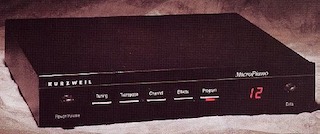
I purchased this because the Achillies heel of the K2VX is limited polyphony. I used this primarily as a piano module, but it also has a very nice set of strings and pad sounds among its 32 sounds.
KORG X5DR

After I gave away my Korg X5 to a friend, i found there were some sounds in it that I still needed, so I got this module for a cut-rate price of a couple hundred bucks so I'd have the X5 sounds still. I no longer use this, but have sampled some sounds from it.
ROLAND JV-2080

I had not owned a Roland since the 80s, and thought (mistakenly) they were second rate compared to Korgs and Kurzweils. Well, when Roland came up with the expandability concept of adding sound cards to their JV-line, I was interested, as I liked the idea of customizing your synth like that. When the JV-2080 came out I was very excited by all of the various expansion cards you could use, so I got this damaged unit on sale (works fine, it's just scuffed up). I then set out jamming it full of all the expansion cards I could; World, Bass & Drums, Techno, Asia, Special FX, Country, Latin, & Experience II.
YAMAHA QY70
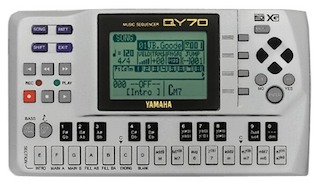
I had a Florida vacation looming in the late 90s and wanted to do some songwriting on my trip. But at that time soft-synths were in their infancy, and I didn't want to carry a laptop around, so I decided to get my first Yamaha synth in a decade. It's about the size of a thick paperback book. I still own this li'l bugger and am still surprised at the quality of the sounds it has. Sure, it's a relic of the late 20th century, but is still a good substitute if I don't have room for my laptop. Compare the QY70 to the Casio VL-1 at the top of this page, and they both have button keys, drums, sequencing, synthesis and a monochrome LCD. Some things don't change much...
YAMAHA FS1R
![]()
This be the last hardware synthesizer I ever bought. After all those years of disliking FM synthesis, I was drawn back to it with this item, which was Yamaha's attempt to expand and enhance FM (and cash in as FM was suddenly cool again). This unit was damaged, like the JV2080, (the knobs were broken off). But it has some good FM sounds, extended algorithms and wild vocal 'formants' which add a dimension as well. The effects are very good, and it does a very good imitation of fuzzy guitars (what I used most often). Because of the FM8 softsynth, I no longer use this item.
Next : The Software Years
